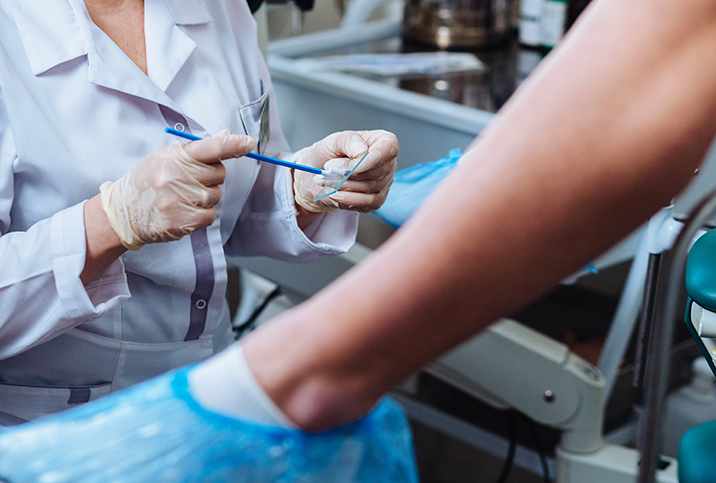Raising Awareness: TogetHER on Eliminating Cervical Cancer Worldwide

Cervical cancer is the fourth most common cancer in women. Globally, more than 600,000 women were diagnosed with cervical cancer in 2020, and more than 300,000 died from the disease. Ninety percent of those cases were in low- to middle-income countries where access to prevention, screening and treatment is limited.
The nonprofit organization TogetHER for Health is dedicated to increasing understanding of the disease and access to resources that will help eliminate cervical cancer around the world. In this exclusive Q&A with Giddy for Cervical Health Awareness Month, Heather White, Dr.PH., executive director at TogetHER, discusses how the organization began, their three-pronged approach to advocacy and some of the projects they've helped fund.
Tell us a bit about yourself and TogetHER for Health.
I'm the executive director of TogetHER for Health and have been in this role since July 2020. I'm a public health specialist by training and have worked in cervical cancer programs since 2009.
While pursuing my doctoral degree in public health in 2011, my research was conducted in Lusaka, Zambia. I wanted to better understand what the screening process was like for Zambian women and appreciate social constructs surrounding cervical cancer. What did cervical cancer mean to the average Zambian woman? Was it a priority for her to get screened, why or why not? How does a health provider talk about cancer and reproductive health issues with a woman?
I was also interested in understanding what perceptions women had around this disease, and how that varied according to women's HIV status. If you look at cervical cancer, women living with HIV—particularly those who aren't on antiretrovirals—are much more likely to have early signs of cervical cancer because of their immune status. Women living with HIV are four to five times more likely to get cervical cancer compared to their peers. So, reaching women living with HIV is a priority. When we think about global screening strategies for women, we think about these women and how best to reach them.
TogetHER was created by two women who felt we needed to do more to raise awareness and funding to fight this disease. Kathy Vizas, TogetHER's chief strategy officer, is one of our cofounders. She and I met when we worked together on a Maverick Collective project in India providing cervical screening and precancer treatment to women.
The government of Uttar Pradesh state in India came to our local team and said they were very interested in bringing these services into a noncommunicable disease clinic for women they were creating, and asked if we could serve as their technical advisors, which we did. Then the government integrated these services into their existing programs and facilities across 28 districts in the state, reaching millions of women. So it was a really big win, and it's still going on today. You can learn more about the project here.
'TogetHER was created by two women who felt we needed to do more to raise awareness and funding to fight this disease.'
Our role in the project came to an end, but Kathy wanted to do more in this field. She connected with a good friend and colleague, Celina Schocken, former executive director at Pink Ribbon Red Ribbon, and TogetHER was born.
TogetHER is predominantly an advocacy organization. Our mandate is about increasing visibility and resource mobilization for cervical cancer around the world.
When we talk about who we are, we talk about it in terms of scale. We want to scale up by looking at structural change and policy change. What policies might be important at a national level to pave the way for increased coverage for HPV vaccination, cervical cancer screening and early treatment?
We scale out by supporting implementing partners to build out healthcare worker capacity and promote best practices in increasing access to services. For example, we want to identify high-risk women early and provide treatment. We work through a large partner network of non-governmental organizations (NGOs) that work in women's health, reproductive health and family planning. They have the infrastructure and personnel in place to be able to deliver these services widely and efficiently in the countries that need them most.
Thirdly, we scale deep by sharing the stories of how individual women are affected, how their families and communities are affected, and ways communities can tackle this disease. We try to understand what resonates in various places and how we can continue to share the importance of prevention through HPV vaccination and cervical cancer screening.
You became executive director shortly after the COVID-19 pandemic began. How did this change your expectations about your role?
In July 2020, everybody was still trying to figure out which way was up in general. We knew vaccination and screening programs around the world were going to be drastically reduced and struggle to meet their targets.
I have to give a lot of credit to my predecessor, Celina Schocken. She handed over the reins at TogetHER for Health with very strong relationships in place. We have ongoing conversations with our partners every month and we have our finger on the pulse of the work happening around the world. At that time, we were watching to see whether the global elimination strategy for cervical cancer was going to be approved by World Health Organization (WHO) Member States—which it was, in late 2020.
The WHO strategy is built on three pillars: vaccination, screening and treatment, with designated targets to meet by 2030. If the world can achieve HPV vaccination for 90 percent of girls by age 15, screen 70 percent of women ages 35 to 45 for precancerous cervical lesions, and if 90 percent of those identified with cervical disease can be treated effectively, then we will be on our way to eliminating this disease globally.
Some countries are already close to elimination. Australia is on track to become the first country to eliminate this disease. The elimination strategy is a huge milestone. It says if we have the right policies, adequate resources and targeted strategies, we can do this. It's the first cancer the WHO has recognized can be eliminated by virtue of increasing vaccination, screening rates and early treatment.
'The WHO strategy is built on three pillars: vaccination, screening and treatment, with designated targets to meet by 2030.'
But at the time, we were trying to understand how things would change, what dynamics would change, and indeed services were reduced early in the pandemic.
In spite of the pandemic, we're working on increasing awareness of cervical cancer and how to prevent it. In late 2020, we approached an NGO called Scope Impact to design and promote a communications campaign for cervical cancer in Kenya.
Scope has a history of working in Kenya, supported by a local team. Kenya has a high burden of cervical cancer, and we felt we could reach a lot of people via social media. In roughly six weeks, we were able to reach 64 million Kenyans via social media, and an additional 29 million via traditional media outlets, with messages about cervical health.
We felt good about our ability to continue to share the importance of prevention and cervical health, and to reach people even if we couldn't physically spend time one-on-one in a clinic. So, that's some good news during the pandemic. COVID continues, of course, which keeps us on our toes.
Tell us more about the Kizazi Chetu project in Kenya.
We developed the Kizazi Chetu campaign together on the heels of the WHO's global elimination strategy. We felt like the elimination strategy—an historic moment—didn't get enough attention because of COVID-19, and so we connected with our partners at Scope to launch Kizazi Chetu. Scope had worked on sexual health and family planning initiatives and we knew they could be provocative in the right ways and help elevate an issue by connecting with new audiences.
So we built out this campaign together in Kenya. Our two teams came together, they brought a number of local influencers on board, created op-eds in the local papers, had radio and TV programming, Twitter chats, and more.
In addition to messaging, the campaign also worked alongside a number of healthcare service providers and looked at the number of services they provided a year prior to the campaign, three months prior to the campaign, and then after. And we saw an impressive uptick in services during the campaign. Now we're hoping to take what we know is powerful media and messaging and work with healthcare providers to ensure that when and if women and girls come through the door, they're receiving a high-quality experience and services.
Kizazi Chetu means "our generation," and an important aspect of this project is that it wasn't a traditional public health campaign. It wasn't about wagging your finger at someone and telling them they need to do this, that, and the other. It was about saying, "What do we need to do from an intergenerational perspective to make sure our moms are screened, our daughters are vaccinated, our wives are supported?" It is a call to action across generations.
TogetHER co-signed a letter to the Biden Administration dated the day before his inauguration asking for help to eliminate cervical cancer worldwide. How can the U.S. government help?
Yes, TogetHER actually drafted the letter and reached out to a coalition of organizations to endorse it. In this case, we felt we had an opportunity, given the transition to this administration, and Biden's personal commitment to cancer control, to advocate for increased federal funding for cervical cancer prevention globally, especially in light of the WHO's elimination strategy.
Where I think the administration has done well and continues to support this space is with the PEPFAR Go Further program, which is a global partnership to bring cervical cancer screening and early treatment to women in countries with high HIV burden. They are the largest single donor in the cervical cancer space, and I hope to see them continue to build out their funding and portfolio.
Because there is a significant synergy between HIV infection and HPV infection—which can lead to cervical cancer—it makes sense to integrate these services. To date, they have screened more than one million women for cervical cancer, and this is great, but there is much more to do. We'd love to see this program expand with congressional support.
The Centers for Disease Control and Prevention (CDC) also does quite a bit of cervical and breast cancer prevention, predominantly in the U.S. and its territories. We would love to see the Biden administration take on a leadership role for cervical cancer prevention in low-income countries, through PEPFAR and through other channels, particularly the United States Agency for International Development (USAID).
TogetHER provides grants of up to $25,000 to organizations. What have some past recipients accomplished with this investment?
We started the Cervical Cancer Grants Program in 2019 to offer small grants to existing cervical cancer programs to address needs in their communities. A lot of this work really comes from people on the ground living in these communities who say, "Women are dying of this disease and we need support." They have family members, friends and people in their communities who have been affected by this disease and they are looking for ways to address the problem.
In the first round of grants in 2019, Jhpiego in Botswana received an award to improve access to precancer treatment for women found with cervical precancer through the use of thermal ablation. They have a strong partnership with the Ministry of Health, and they used our grant to procure devices, train health providers and integrate this work into their quality assurance teams. A $25,000 grant from us was able to go a long way.
Once they put that program in place, the Ministry of Health approved thermal ablation as part of its national guidelines for the treatment of cervical precancer. The CDC came along after that initial onset and donated more of these devices to the program.
The other grantee from 2019 was MoviCancer in Nicaragua. They were working with the American Cancer Society and with us to build out the training and clinical support to increase access for precancer treatment using thermal ablation devices. These devices are a game-changer for treating early signs of cervical precancers. They are lightweight, portable and run on a battery pack, a much more efficient and convenient technology than what is traditionally used for treating early, precancer lesions.
We've recently awarded four grants to organizations in Malaysia, Rwanda, Cameroon and Kenya that will be implemented over the course of 2022, and we're excited to share their learning.
January is Cervical Health Awareness Month. What are some of the initiatives TogetHER accomplished, and what are the organization's goals for 2022?
We hosted a webinar on January 20 with colleagues from Pepal, which provides leadership development for individuals working in cervical cancer. We're also promoting the group Global Initiative Against HPV and Cervical Cancer (GIAHC). They did a whole series of events this month, including a screening of an exciting documentary called "Conquering Cancer," which highlights the challenges women face with this disease, progress being made to address it and how people can support this issue.
As for TogetHER's goals for 2022, we plan to expand the Kizazi Chetu campaign with our partners at Scope Impact to reach more people with messages on cervical health, to work directly with health providers to ensure quality services, and to examine the policy environment in Kenya to expand improved screening through HPV DNA testing and other technologies.
Next, we will continue to work on our advocacy strategies with the U.S. government to promote, and hopefully secure, funding through U.S. government agencies for global cervical cancer prevention. Ultimately, for us, it's about continuing to promote funding and sharing why this issue is important, not only for women around the world, but also women in the U.S.
Finally, we'll continue to share and promote our partners' work, as well as smaller organizations that may not get as much attention or have a global platform. We do a quarterly webinar series, so we'll continue to promote important issues in that space. We'll also be collecting insights and achievements from our grantees as the year progresses and sharing those.
Do you have any final thoughts you'd like to share with our readers?
Many women who go in for an annual Pap smear don't necessarily know it's a test for cervical cancer. There is a lot of health education that can and should be done here in the U.S. to simply help make women aware, not only of the importance of those annual exams for themselves, but so they can share the importance of HPV vaccination with their daughters.
While we work predominantly around the world, we know the messaging and the importance of regular checkups and regular preventive care is equally important here, and we are happy to connect with anybody who is interested in learning more about the topic, as well as how they can support this work. The interesting thing about cervical cancer is you can have a significant impact in this space with relatively few dollars.


















